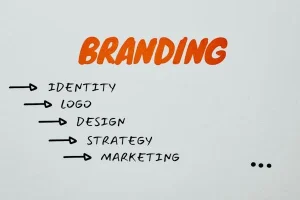In the dynamic landscape of business, establishing a strong brand identity is vital for success and longevity. Among the myriad tools available to achieve this, effective branding design stands out as a cornerstone.
It’s not merely about creating a visually appealing logo or choosing the right colors; rather, it’s about strategically crafting a cohesive identity that resonates with your audience and sets you apart from competitors.
Defining Business Branding Design

At its core, branding design encompasses the visual elements that communicate a company’s values, mission, and offerings. This includes logos, colour schemes, typography, and overall aesthetic.
However, effective branding design extends beyond aesthetics to evoke emotions, convey a story, and build credibility. It’s about creating a holistic experience that connects with consumers on a deeper level.
The Impact of Strong Branding
A well-executed branding design strategy yields numerous benefits for businesses:
-
Memorability
A strong branding strategy enhances memorability by creating a distinctive visual identity that consumers can easily recognize and recall. A well-designed logo, consistent color palette, and unique typography contribute to this memorability.
When customers repeatedly encounter these visual elements across various touchpoints (such as websites, social media, and packaging), they start associating them with your brand. This association strengthens over time, making your brand more memorable amidst competition.
-
Trust and Credibility
Consistent branding builds trust and credibility with consumers. When a brand maintains a cohesive and professional image across all platforms, it signals reliability and stability. Consumers are more likely to trust businesses that appear reputable and well-established. Strong branding communicates that a company pays attention to detail and cares about its overall image, which can positively influence purchase decisions.
-
Differentiation
In a crowded marketplace, effective branding helps businesses stand out from competitors. A unique visual identity sets your brand apart and makes it more recognizable. By clearly communicating your brand’s values, personality, and offerings through design elements, you create a distinct impression in the minds of consumers.
This differentiation is crucial for attracting your target audience and gaining a competitive edge.
-
Emotional Connection
Strong branding design goes beyond aesthetics; it evokes emotions and fosters a deeper connection with consumers. By aligning your brand’s visual identity with its core values and mission, you can create meaningful associations and resonate with your audience on an emotional level.
When consumers feel emotionally connected to a brand, they are more likely to develop loyalty and become advocates, leading to long-term relationships and increased brand affinity. We strongly recommend that you leverage the expertise of brand strategists, such as Deuce Studio Design Agency London, to bring your branding strategy to life.
Key Elements of Effective Branding Design

-
Logo
The logo is the centerpiece of your brand identity and often the first visual element consumers encounter. A well-designed logo should be simple, memorable, and reflective of your brand’s personality and values. It should be versatile enough to look good across various mediums and sizes, from digital screens to printed materials.
A strong logo creates instant recognition and serves as a visual anchor for your brand’s identity.
-
Colour Palette
Colours play a crucial role in branding as they evoke specific emotions and associations. When choosing a colour palette for your brand, consider the psychological impact of different colours and how they align with your brand’s message. For example, blue can convey trust and reliability, while red can evoke excitement or passion.
Consistency in color usage across all branding materials helps reinforce brand recognition and creates a unified visual identity.
-
Typography
Typography refers to the fonts and typographic styles used in your brand’s design. The choice of typography should reflect your brand’s tone, personality, and target audience. For instance, a sleek and modern sans-serif font might convey a sense of innovation, while a classic serif font could suggest tradition or elegance.
Consistent typography across all communications maintains brand cohesion and reinforces brand recognition.
-
Visual Consistency
Visual consistency is key to effective branding design. This means using the same design elements (logo, colors, typography, imagery) across all brand touchpoints, including websites, social media, marketing materials, and product packaging.
Consistency creates a cohesive brand experience and helps build brand recognition. It also instills confidence in consumers by presenting a unified and professional image.
-
Storytelling
Effective branding design should tell a compelling story about your brand. Through visuals, imagery, and layout, convey your brand’s values, mission, and unique selling proposition. Use design elements to evoke emotions and create a narrative that resonates with your target audience.
By weaving storytelling into your branding, you can establish a deeper connection with consumers and differentiate your brand in a meaningful way.
Creating Your Branding Strategy

Creating a comprehensive branding strategy involves several key steps and considerations. Let’s delve into each point in detail:
-
Know Your Audience
Understanding your target audience is fundamental to developing a successful branding strategy. Conduct market research to identify demographic information, preferences, behaviors, and pain points of your potential customers. This knowledge will guide your branding decisions, ensuring that your visual identity and messaging resonate with your audience and address their needs effectively.
-
Define Your Brand Identity
Clarify your brand’s identity by defining its values, mission, personality, and unique selling propositions (USPs). Determine what sets your brand apart from competitors and how you want to be perceived by your audience. Your brand identity should be authentic and aligned with the core beliefs of your business, reflecting who you are and what you stand for.
-
Competitor Analysis
Analyzing competitors is crucial to identify market gaps and opportunities for differentiation. Study your competitors’ branding strategies, visual identities, messaging, and market positioning. Identify their strengths and weaknesses to carve out a distinct space for your brand.
Differentiation is key to standing out in a competitive landscape, and competitor analysis provides valuable insights for strategic decision-making.
-
Iterate and Refine
Developing a branding strategy is an iterative process that requires continuous refinement based on feedback and insights. Test different elements of your branding, such as logo variations, color schemes, and messaging, to gauge audience response.
Solicit feedback from stakeholders, customers, and industry experts to identify areas for improvement and optimization. Use data and analytics to measure the effectiveness of your branding efforts and make informed adjustments as needed.
Conclusion
In the ever-evolving world of business, effective branding design is a potent tool for success. It’s not just about aesthetics; it’s about creating a lasting impression, fostering trust, and building meaningful connections with your audience.
By investing in a robust branding design strategy, businesses can elevate their presence, stand out in competitive markets, and cultivate enduring relationships with customers.
Author Profile

- Informed content writer and creator in the UK, always on the lookout for new stories, developments and trends to share.
Latest entries
 EnvironmentJune 23, 2025Moving to Paper-Based Disposable Tableware: A Guide on Best Sustainable Practices
EnvironmentJune 23, 2025Moving to Paper-Based Disposable Tableware: A Guide on Best Sustainable Practices Must Read NewsJune 4, 2025The Importance of Ohm’s Law in Modern Electrical Circuit Design & Renewable Energy
Must Read NewsJune 4, 2025The Importance of Ohm’s Law in Modern Electrical Circuit Design & Renewable Energy Business AdviceMarch 18, 2025Beyond Traffic Bots: Sustainable Paths to Real Business Growth
Business AdviceMarch 18, 2025Beyond Traffic Bots: Sustainable Paths to Real Business Growth BusinessMarch 4, 2025Renewable Energy in the UK – Business Opportunities Towards a Greener Future
BusinessMarch 4, 2025Renewable Energy in the UK – Business Opportunities Towards a Greener Future


